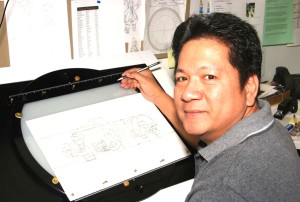A Filipino brings to life Bart Simpson’s antics

Jess Española proudly poses with his Emmy trophy in 2008 for his work on “The Simpsons.” CONTRIBUTED
SAN FRANCISCO — Who knew that the guy who brings Bart Simpson and his family to life is Filipino? Not just “The Simpsons,” but also the Hanna-Barbera characters that we watched as kids.
Meet Jess Española, 56, a fine arts graduate of University of the Philippines whose first cartoon heroes Batman and Robin — drawn on his notebooks or done as art work — were first displayed on bulletin boards in an elementary school in Pampanga. He is now assistant director for “The Simpsons” and has won an Emmy for his work on the animated TV show.
Española started drawing when he was five years old — mainly what he saw, like houses, persons, the sky with clouds, a small canal beside their house — even before he could write his name. He was a left-handed, but his mother forbade him because of the superstition that everything left was bad. Since then, he has used his right hand in writing and drawing.
Raised by a single mother, Española grew up in Caloocan and later moved to Pampanga at the age of nine when his mother got married. He stopped schooling for two years because of poverty. But this did not lessen his desire to study. To get by, he worked on farms after school, and would collect edible snails in the river and to boil them with lemon grass for the family’s meal.
School artist
Despite the difficulties, Española never forgot his art. When his teachers discovered that he could draw well, they asked him to draw for their bulletin boards. He got paid for it. He became the school artist, and the money he earned went mostly for food. He finished primary school as a valedictorian, but had to stop for another year due to lack of money.
At 15 years old, Española went to Manila and worked as an errand boy and a dishwasher. In high school, he met an old practical arts teacher who was a graduate of UP Fine Arts and had a studio in Quiapo. Seeing Española’s talent, the teacher encouraged him to train in charcoal portraiture. He still got paid to draw portraits. His desire to study was so strong that even without enough money, he wanted to pursue his education.
His old journalism teacher, Elma Baking, and her nephew, Oscar Pineda, a senior student at UP College of Fine Arts, offered him help. With mentoring from Pineda, he was able to pass the talent test in UP but could not enroll full time because he was working. Espanola, seeking his biological father, met his half-brother, Renato, who in turn brought him to their home. Knowing his situation, his stepmother asked the help of Karina Constantino-David. Upon meeting him, David paid his tuition and gave him a temporary job. Eventually, he became a college scholar, but hunger and poverty still haunted him.
“I had to tell a classmate to double his lunch meal and give me half of it. I had to tell some of my teachers I was hungry and to recommend me for any job they knew. I chose to major in painting and studio arts because I had a big dream of becoming a National Artist,” says Española.
Working in animation
After graduating, Española started as cleanup/in-betweener and animator in Burbank Animation, an Australian based studio in Makati producing animated shows for European viewership. In 1986, Hanna-Barbera from Los Angeles set up shop in the Philippines and hired Optifex studio, in Makati, and also worked on a few shows like “Johnny Quest” through its subsidiary, Fil-Cartoons Inc. in Pasig, which was considered one of the biggest animating operations in Asia.
“I worked as an animator for all the Hanna-Barbera shows. In 1991, in some sort of a reward for my good performance, I was sent to the mother studio in the US for an orientation tour and stayed there for less than three months,” says Española.
When the Fil-Cartoons downsized in 1994, Española worked in CD-ROM education and entertainment for children. Now in America, Española started to work at Film Roman for “King of the Hill,” one of 20th Century Fox primetime shows, which includes “The Simpsons” created by Matt Groening. He started as lay out artist for “King of the Hill,” soon became an assistant director for a season then he moved to Rough Draft for “Futurama” (another Fox primetime show created by Matt Groening) in 1998 also as assistant director. He stayed with “Futurama” until it stopped airing in 2002.
“I went back to Film Roman as a layout artist for ‘The Simpsons’ in 2003. I eventually became assistant director again. In 2008, the episode ‘Eternal Moonshine of the Simpson Mind’ won an Emmy. I got a trophy,” Española beams.
Secrets to artistic success
Española says that in animation studios in Hollywood, talent and creativity, good drawing skills and the ability to handle and meet the deadlines are the determining factors for keeping the job. If an artist is an asset to the company, race or ethnicity doesn’t matter, he says. There is no gender discrimination either. He says that many Filipinos are working in animation studios, like Nestor Redondo and Alex Niño who came before him.
Española shares his knowledge and experiences with artists in the Philippines through his talks and lectures at UP College of Fine Arts, Holy Angel University in Pampanga and Animation Council of the Philippines’ Animahenasyon Festival at De La Salle University and Eastwood City. Española and other Filipino artists are building the American Museum of Philippine Arts (AMPA) to be located near or within Greater Los Angeles.
“We have great artists in the Philippines, but we don’t have a system that promotes the industry. That’s the main reason our talents go abroad to find a better opportunity for themselves. As for the small animation studios in the country, they have been competing instead of supporting each other the way the Koreans do,” Española laments.
Española has this to say to artists: “You need to find love in what you do to pursue your dream and be great in your chosen career. By practicing your skill, it refines your craft, that’s the secret to being a great artist.”
Española will receive Gawad Amerika Award on November 16. He will be in the Philippines in November for a TED Talks sponsored by iACADEMY in Manila.















